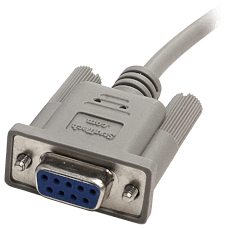Serial Port
A serial port is a type of hardware interface found on personal computers from the late 1980s to the early 2000s. They were also called COM ports or RS-232 ports. Serial ports were used to connect peripherals like modems, game controllers, and mice. While generally considered obsolete in personal computing following the introduction of the USB port, serial ports are still used in embedded computers in industrial and scientific fields.
Serial port connections transmit data one bit at a time in a single data stream, unlike parallel ports that transmit multiple bits simultaneously in parallel. A serial port uses different pins to send and receive data, making the connection bi-directional. Serial port connections are slower than parallel port connections, but the simpler technology means that serial port cables and connections are smaller and less expensive to implement.
Multiple sizes of serial port connectors were commonplace; the most common types were 9-pin DE-9 and 25-pin DB-25 ports. Apple Macintosh computers used an 8-pin Mini-DIN connection for their serial ports. In the late 90s, the Universal Serial Bus (USB) standard arrived to replace the various serial ports (as well as the parallel port), addressing the shortcomings of the older standards. It offered higher speeds, plug-and-play compatibility, and the ability to provide more power to peripherals.
Modern Uses of Serial Ports
While serial ports are obsolete in personal computing, they're still commonly used in other settings. Serial ports are simple, reliable, and cheap to implement on small low-power devices with specific uses. In many specialized devices, like industrial controllers and medical equipment, a simple wired connection that sends small amounts of data is all that is required. In many cases, they are still used simply because a device was designed back when serial ports were common, but is still dependable and doesn't require a redesign and replacement.
Industrial automation equipment and scientific instruments still use serial ports to exchange data and configuration settings with computers. Large-scale networking equipment also often uses serial ports for diagnostic and configuration connections. Instead of replacing otherwise-reliable equipment just to implement a newer port, administrators can instead connect to these devices using a USB-to-serial adapter.
 Test Your Knowledge
Test Your Knowledge
